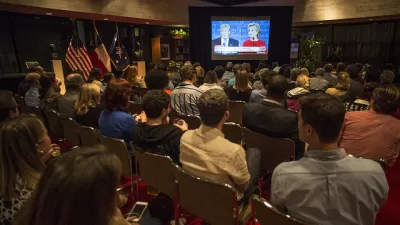One of the few mentions of cities during the second presidential debate came when Donald Trump described the states of "inner cities" in the country. The explanation didn't sit well with some experts.

Republican presidential candidate Donald Trump described inner cities as "a disaster education-wise, jobwise, safety-wise, in every way possible" during the second presidential debate, inspiring criticism from multiple experts on contemporary urbanism.
Emily Badger, for instance, debunks Donald Trump' mention of "inner cities" from several angles:
"Inner city," in short, is imprecise in describing today’s urban reality. It captures neither the true geography of poverty or black America, nor the quality of life in many communities located in central cities.
To prove the pint that neighborhoods previously thought of as "inner cities" are now performing very well economically, Badger cites a recent analysis by researchers at the Federal Housing Finance Agency, which "found that home values have risen faster in the heart of big cities than anywhere else in the country over the last 25 years, a sign of their turnaround and a trend Mr. Trump, as a real estate developer, is likely to be aware of."
Kristen Jeffers has also written a critique of Trump's "inner cities" word choice, explaining the concentric city model and its importance to planning and development in the process.
FULL STORY: Actually, Many ‘Inner Cities’ Are Doing Great

Alabama: Trump Terminates Settlements for Black Communities Harmed By Raw Sewage
Trump deemed the landmark civil rights agreement “illegal DEI and environmental justice policy.”

Study: Maui’s Plan to Convert Vacation Rentals to Long-Term Housing Could Cause Nearly $1 Billion Economic Loss
The plan would reduce visitor accommodation by 25% resulting in 1,900 jobs lost.

Planetizen Federal Action Tracker
A weekly monitor of how Trump’s orders and actions are impacting planners and planning in America.

Wind Energy on the Rise Despite Federal Policy Reversal
The Trump administration is revoking federal support for renewable energy, but demand for new projects continues unabated.

Passengers Flock to Caltrain After Electrification
The new electric trains are running faster and more reliably, leading to strong ridership growth on the Bay Area rail system.

Texas Churches Rally Behind ‘Yes in God’s Back Yard’ Legislation
Religious leaders want the state to reduce zoning regulations to streamline leasing church-owned land to housing developers.
Urban Design for Planners 1: Software Tools
This six-course series explores essential urban design concepts using open source software and equips planners with the tools they need to participate fully in the urban design process.
Planning for Universal Design
Learn the tools for implementing Universal Design in planning regulations.
Caltrans
Smith Gee Studio
Institute for Housing and Urban Development Studies (IHS)
City of Grandview
Harvard GSD Executive Education
Toledo-Lucas County Plan Commissions
Salt Lake City
NYU Wagner Graduate School of Public Service




























